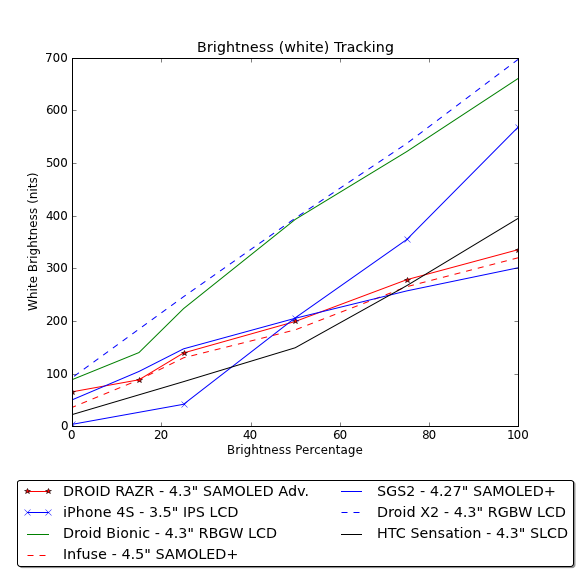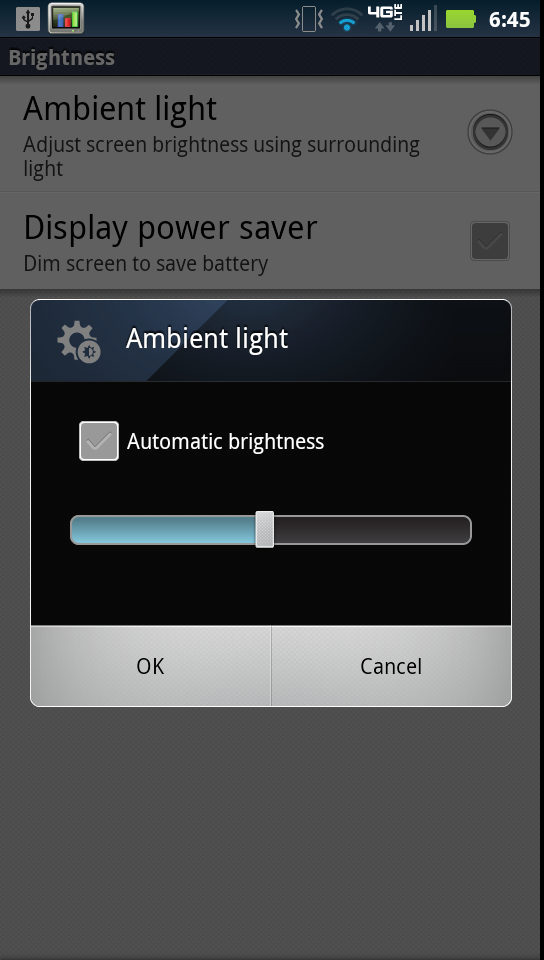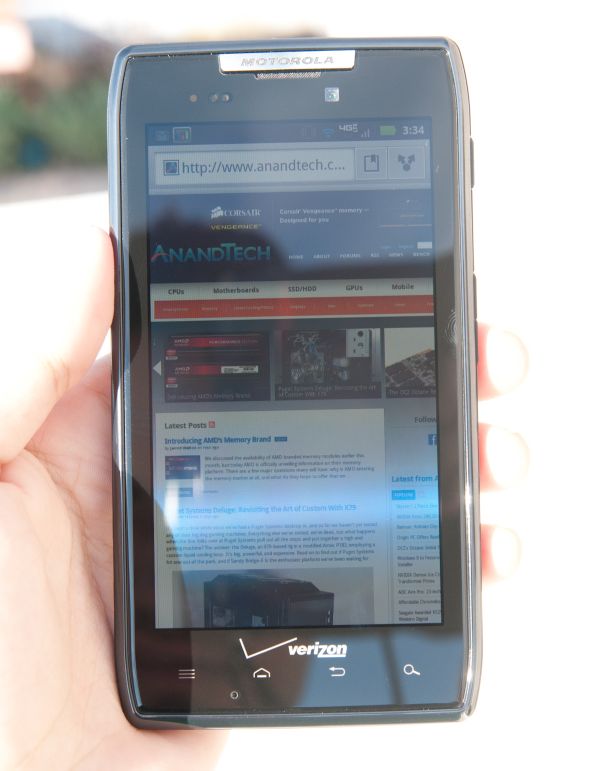Motorola Droid RAZR Review - A Better Clad Bionic
by Brian Klug on December 16, 2011 2:01 AM EST- Posted in
- Smartphones
- Droid
- LTE
- 4G
- Motorola
- Android
- Mobile
- Droid RAZR
- motorola droid RAZR
Super AMOLED Advanced Display
The RAZR is the first Motorola device to ship with an AMOLED panel, and in this case they’ve coined their 4.3” diagonal qHD (960x540) display Super AMOLED Advanced. True to AMOLED naming monikers, this panel includes RGBG PenTile (the absence of “Plus” tells you this one) and Advanced apparently now connotes qHD.
It seems like PenTile is something that mainstream press has finally become aware of, and for whatever reason, the RAZR served as lightning rod for others to voice their discontent with the non-RGB stripe subpixel rendering layout. Maybe it’s because the phone isn’t Samsung-branded (although ironically it is undoubtably manufactured by Samsung), but something about the RAZR display caused more than the usual scrutiny. I think a little bit of a history lesson is in order - since the original Atrix, Motorola has been shipping qHD LCD panels with the RGBW variant of PenTile. The fourth white subpixel helps the LCD system be more efficient - especially when displaying black text on a white background. In that system, luminance gets mapped to the white subpixel, chrominance to RGB.

Some AMOLEDs (Left to Right): SAMOLED (Galaxy S), SAMOLED+ (Galaxy S 2), SAMOLED Advanced (RAZR)
In AMOLED land thus far we’ve only seen RGBG PenTile or RGB subpixel matrixes. By taking advantage of the human visual system’s differing frequency response with respect to wavelength (eg we can detect higher spatial frequencies in the green), the system can emulate a higher resolution system with fewer subpixels. First and second generation AMOLED (“AMOLED” on the Nexus One and others, then Super AMOLED on the Galaxy S / Nexus S) drove an effective resolution of WVGA (800x480) at 3.7” and then 4”, and it was here that subpixels were big enough to pick out with the naked eye, especially on solid colors or single pixel thickness elements.
The thing that gets left out of most discussions about the RAZR’s display is that although RGBG is used, the subpixels have a different geometry than their RGBG first and second generation (AMOLED and Super AMOLED) partners from Samsung. Previously, green subpixels were noticeably thinner than their R and B partners. In this new matrix, they’re much closer to being same size (this also applies to the Galaxy Nexus and any of the new Samsung AMOLED panels that don’t use RGB stripes).
With respect to the RAZR, the combination of this more uniform subpixel geometry and higher effective resolution (qHD) at 4.3” makes RGBG PenTile nowhere near as visually noticeable as it was on phones like Galaxy S. I originally tweeted that I found the RAZR display visually different than other AMOLED panels with RGBG, and this is what I was referring to. Subjectively I’d even say that the RAZR has less characteristic PenTile grain than the RGBW LCD variants I’ve seen recently.
Of course the other side of the story is color rendering and accuracy. One of the most frustrating things with AMOLED that has existed in virtually every iteration is how white point varies sometimes wildly as a function of panel brightness. If you use auto brightness (which I wager almost everyone does to save battery), it can change dramatically and be accentuated by ambient lighting changes that accompany. I set out to measure how much change there is a while ago, and continue measuring brightness, contrast, and white point at different brightness percentages as set in the UI.


Like virtually all AMOLED displays I’ve seen, there’s subjective variance in appearance as a function of brightness. On the RAZR, the measurements with our i1D2 belies how big this is, and at the absolute lowest brightness settings greys can look somewhat green. Again we’ve seen this behavior on numerous AMOLED displays.

I also threw the RAZR at Color HCFR and took measures with Francois’ excellent voodoo screen test patterns application at 100% brightness. The results from a complete run (results in .chc format are here if you want them) are interesting. Starting with the CIE chart, we see the kind of oversaturation that has been long talked about with respect to AMOLED - the inside triangle is the sRGB standard, outside are primary and secondary measures.
Color temperature straddles 6500K and mirrors what measures I took and mentioned elsewhere, of course here we’re looking at it at different IRE values. Likewise, gamma is way above 2.2 and instead average 2.6.
Viewing angles and outdoor response are what we’re used to seeing from SAMOLED. That is to say viewing angles are awesome and outdoor response with an optically bonded panel and top glass isn’t anything to complain about.
I also haven’t seen the RAZR throw a display overheat warning and clamp display brightness either, which is more than I can say for virtually all of the SGS2 variants that I've seen, all of which will throw the overheat error if left in direct sunlight in my climate for too long.


There's two other little things to make note of. First, Motorola made a change to its standard multitouch keyboard and changed the keys to black - this is an interesting and nice little extra feature that might save a bit of battery power. Again, black on AMOLED literally corresponds to the pixels not emitting any light. Last, there's a display power saver checkbox which dims the screen when displaying darker content to save battery - this isn't any surprise, but it's just noteworthy that Samsung isn't alone in including sort of a dynamic contrast function in the guise of saving some battery.

















76 Comments
View All Comments
secretmanofagent - Friday, December 16, 2011 - link
Brian, have you seen any data connectivity issues that plague the Droid Bionic on the RAZR? It was something Verizon confirmed was a known issue (there was a patch released yesterday but don't know if that addressed that issue) and was happening to me quite frequently. I managed to move from the Bionic to the RAZR because of Verizon, and I've seen some hiccups that looked similar to the Bionic issue (it's the same LTE and CDMA baseband).flyfishin69 - Sunday, December 18, 2011 - link
I to am an (almost) former owner of the Bionic. The phone will loose all cellular data after coming in contact with 4g and trying to negotiate back to 3g. And especially in the Hagerstown Md. Area where verizon has no 3g service only 4. I would always find the bionic lifeless. I spoke with a verizon rep and he is sending my Razr tomm. Are we seeing these same problems in the Razr?Nfarce - Sunday, December 18, 2011 - link
Hmmm. I have had the Bionic for three months, since it first came out, and never had a single issue. Here in the greater metro Atlanta area I go between 4G and 3G all the time depending on how far outside the city. I have roamed all over the Southeast while driving and never had a problem either.Sounds to me like you just got a lemon.
secretmanofagent - Monday, December 19, 2011 - link
Nope, they weren't lemons. Check out Verizon's update:http://www.droid-life.com/2011/12/08/droid-bionic-...
Big one is "Improved stability of data connections on 3G and 4G". Worst part for those who still have it: Verizon says it will "help alleviate" the problem.
You're only one of three people that I know of who have said they weren't affected, out of about 10-15. Consider yourself lucky.
Nfarce - Tuesday, December 20, 2011 - link
Yes I guess I was lucky. I actually had no idea this update was even coming until trying to make a call Thursday evening last week. About the only gripe I had of the phone was the crappy autofocus problem. It seems to be a lot better now. I surmise the 3G/4G issue depended at least to some extent what region of the nation you lived in. Two co-workers have the phone (one got a RAZR and gave the Bionic to his wife) and neither reported problems either.secretmanofagent - Monday, December 19, 2011 - link
I've seen a couple times like what I had seen with the Bionic, but only momentary losses.loribeth - Tuesday, December 27, 2011 - link
Both 4G and 3G data drops for me. I live 30 miles north of Indy, which is 3G, but work in 4G territory. The upgrade has not helped and only created other buggy issues.LoneWolf15 - Friday, December 16, 2011 - link
I just did a lot of research before picking up a phone this week. The RAZR was among the half a dozen smartphones I considered --until I picked it up.I have relatively large hands with long fingers, and the phone is STILL too wide to comfortably hold in the hand. It's actually wider than the Droid Bionic (which I did purchase), and its relative thin-ness makes it less comfortable in the hand rather than more. Making a slightly thicker phone, and using that extra thickness to increase battery size would have actually made it more comfortable.
Of course, that would make the phone a Droid Bionic. Which is now $100 cheaper due to the RAZR coming out, so you can save $100 and get a phone that's every bit as capable, with more battery options. They also released a major update to the Bionic this week that squashed a ton of bugs.
At the $299 price, I'd probably look at the Galaxy Nexus or the HTC Rezound --not the RAZR. The Bionic is a much better value if you want a Motorola phone. So far, I'm happy with mine.
Nfarce - Sunday, December 18, 2011 - link
Yep, I like the feel of the Bionic more than the RAZR. I got the thin rubber-like enclosing protective case and it helps even more on the grip. My friend's RAZR feels too fragile and I'd definitely be more worried about dropping it. Thinner isn't always better to some of us.I would have waited for a price drop on the Bionic, but since my older Droid died and I was going month to month without a contract, I had to buy a new phone like yesterday, and in September, the Bionic was the best. Verizon threw in $70 worth of free accessories for me at the full $299 purchase price, so that eased the pain a little (case, car charger, screen protector).
JonnyDough - Saturday, December 17, 2011 - link
"Thankfully holding volume down and power/lock for 10 seconds reboots the device even when the device is totally unresponsive (which I did in fact encounter once)."Something I often encountered on my original DROID and also on my Thunderbolt 4G LTE. I'm honestly a bit sick of the issues with Android. You would think they would fix them. My phone has been known to do some really quirky stuff. From calling people on contact lists from that others who share a phone plan with me have on THEIR phones (the people my phone called are NOT on my phone!), to random reboots, SMS's not sending, and the 3G/4G service acting dodgy, even though I may not leave the house for awhile. Those are just a few of the issues I have suffered through over the last 2 years.